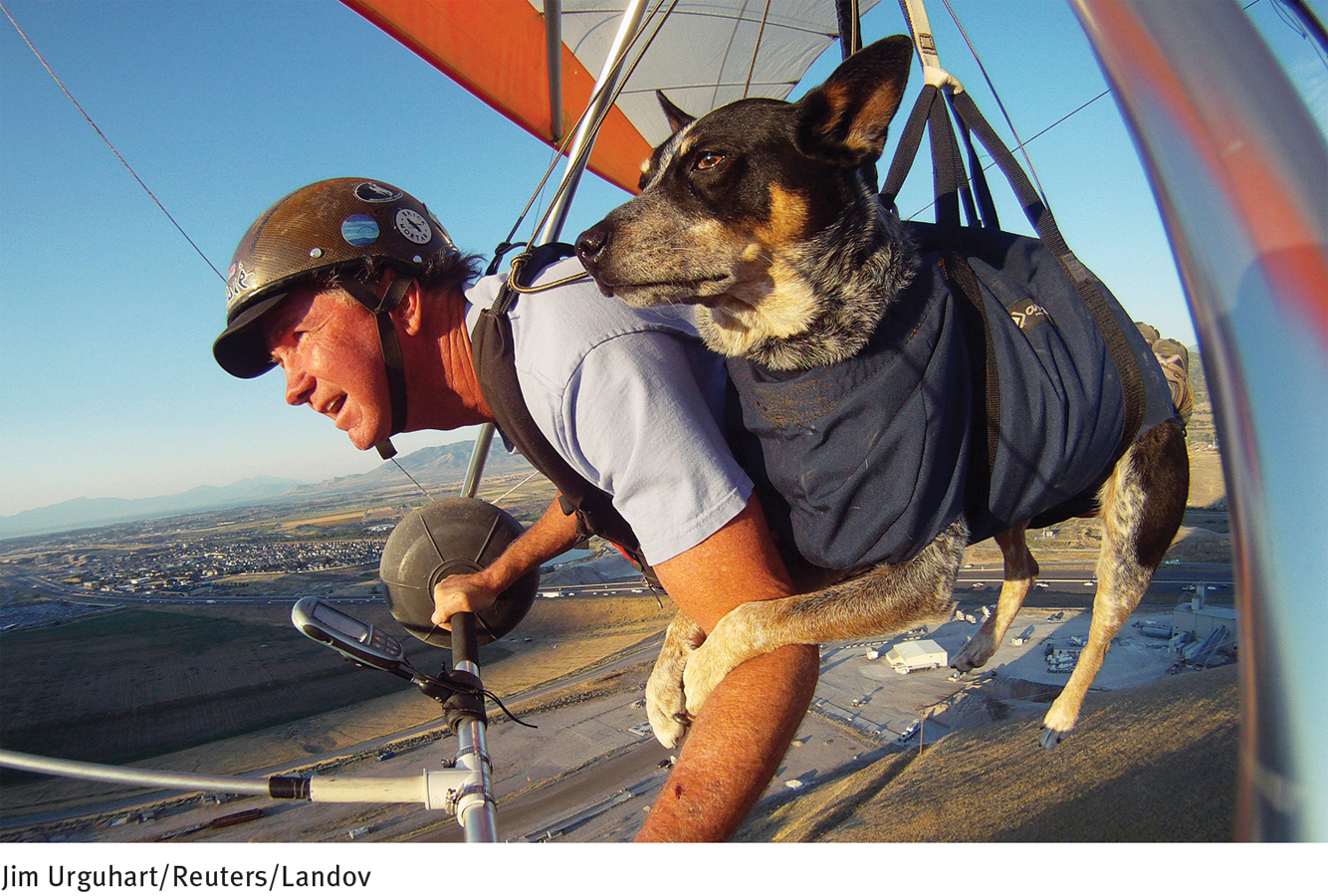5.3 Social Anxiety Disorder
Many people are uncomfortable when interacting with others or talking or performing in front of others. A number of entertainers and sports figures, from singer Barbra Streisand to baseball pitcher Zack Greinke, have described episodes of significant anxiety before performing. Social fears of this kind certainly are unpleasant, but usually the people who have them manage to function adequately.
Why do so many professional performers seem prone to performance anxiety? Might their repeated exposure to audiences have a therapeutic effect?
People with social anxiety disorder, by contrast, have severe, persistent, and irrational anxiety about social or performance situations in which they may face scrutiny by others and possibly feel embarrassment (APA, 2013) (see Table 5-7). The social anxiety may be narrow, such as a fear of talking in public or eating in front of others, or it may be broad, such as a general fear of functioning poorly in front of others. In both forms, people repeatedly judge themselves as performing less competently than they actually do (see MindTech below). It is because of its wide-
 social anxiety disorder A severe and persistent fear of social or performance situations in which embarrassment may occur.
social anxiety disorder A severe and persistent fear of social or performance situations in which embarrassment may occur.
|
Social Anxiety Disorder |
|
|---|---|
|
1. |
Pronounced, disproportionate, and repeated anxiety about social situation(s) in which the individual could be exposed to possible scrutiny by others, typically lasting 6 months or more. |
|
2. |
Fear of being negatively evaluated by or offensive to others. |
|
3. |
Exposure to the social situation almost always produces anxiety. |
|
4. |
Avoidance of feared situations. |
|
5. |
Significant distress or impairment. |
|
Information from: APA, 2013. |
|
Social anxiety disorder can interfere greatly with one’s life (Cooper, Hildebrandt, & Gerlach, 2014; Ravindran & Stein, 2011). A person who cannot interact with others or speak in public may fail to carry out important responsibilities. One who cannot eat in public may reject meal invitations and other social offerings. Since many people with this disorder keep their fears secret, their social reluctance is often misinterpreted as snobbery, lack of interest, or hostility.
Surveys reveal that 7.4 percent of people in the United States and other Western countries (around 60 percent of them female) experience social anxiety disorder in any given year (see Table 5-8). Around 13 percent develop this disorder at some point in their lives (Kessler et al., 2012; Alfano & Beidel, 2011). It tends to begin in late childhood or adolescence and may continue into adulthood. At least one-
|
|
One- |
Female to Male Ratio |
Typical Age at Onset |
Prevalence Among Close Relatives |
Percentage Currently Receiving Clinical Treatment |
|---|---|---|---|---|---|
|
Generalized anxiety disorder |
4.0% |
2:1 |
0– |
Elevated |
25.5 |
|
Specific phobia |
12.0% |
2:1 |
Variable |
Elevated |
19.0 |
|
Agoraphobia |
1.7% |
2:1 |
15– |
Elevated |
20.9 |
|
Social anxiety disorder |
7.4% |
3:2 |
10– |
Elevated |
24.7 |
|
Panic disorder |
2.4% |
5:2 |
15– |
Elevated |
34.7 |
|
Obsessive- |
1.0%–2.0% |
1:1 |
4– |
Elevated |
41.3 |
|
Information from: NIMH, 2011; Kessler et al., 2010, 2005, 1999, 1994; Ritter et al., 2010; Ruscio et al., 2007; Wang et al., 2005; Regier et al., 1993. |
|||||
Research finds that poor people are 50 percent more likely than wealthier people to have social anxiety disorder (Sareen et al., 2011). Moreover, in several studies African Americans and Asian Americans, but not Hispanic Americans, have scored higher than white Americans on surveys of social anxiety (Melka et al., 2010; Polo et al., 2011; Stein & Williams, 2010). In addition, a culture-
What Causes Social Anxiety Disorder?
The leading explanation for social anxiety disorder has been proposed by cognitive theorists and researchers (Iza et al., 2014; Heimberg, Brozovich, & Rapee, 2010; Hofmann, 2007). They contend that people with this disorder hold a group of social beliefs and expectations that consistently work against them. These include:
They hold unrealistically high social standards and so believe that they must perform perfectly in social situations.
They view themselves as unattractive social beings.
They view themselves as socially unskilled and inadequate.
They believe they are always in danger of behaving incompetently in social situations.
They believe that inept behaviors in social situations will inevitably lead to terrible consequences.
They believe that they have no control over feelings of anxiety that emerge in social situations.
Cognitive theorists hold that, because of these beliefs, people with social anxiety disorder keep anticipating that social disasters will occur, and they repeatedly perform “avoidance” and “safety” behaviors to help prevent or reduce such disasters (Moscovitch et al., 2013). Avoidance behaviors include, for example, talking only to people they already know well at gatherings or parties. Safety behaviors include wearing makeup to cover up blushing.

Beset by such beliefs and expectations, people with social anxiety disorder find that their anxiety levels increase as soon as they enter into a social situation. Moreover, because they are convinced that their social flaws are the cause of the anxiety, certain that they do not have the social skills to deal with the situation, and concerned that they cannot contain their negative arousal, they become filled with anxiety.
Later, after the social event has taken place, the individuals repeatedly review the details of the event. They overestimate how poorly things went and what negative results may take place. These persistent thoughts actually keep the event alive and further increase the individuals’ fears about future social situations.
Researchers have indeed found that people with social anxiety disorder manifest the beliefs, expectations, interpretations, and feelings listed here (Moscovitch et al., 2013; Rosenberg et al., 2010). At the same time, cognitive theorists often differ on why some individuals have such cognitions and others do not. Various factors have been uncovered by researchers, including genetic predispositions, trait tendencies, biological abnormalities, traumatic childhood experiences, and overprotective parent-
Treatments for Social Anxiety Disorder
Only in the past 15 years have clinicians been able to treat social anxiety disorder successfully (Rosenberg et al., 2010). Their newfound success is due in part to the growing recognition that the disorder has two distinct features that may feed upon each other: (1) sufferers have overwhelming social fears, and (2) they often lack skill at starting conversations, communicating their needs, or meeting the needs of others (Beck, 2010). Armed with this insight, clinicians now treat social anxiety disorder by trying to reduce social fears, by providing training in social skills, or both.
How Can Social Fears Be Reduced?Social fears are often reduced through medication (Pelissolo & Moukheiber, 2013; Ravindran & Stein, 2011). Somewhat surprisingly, it is antidepressant medications that seem to be the drugs of most help for this disorder, often more helpful than benzodiazepines or other kinds of antianxiety medications. At the same time, several types of psychotherapy have proved to be at least as effective as medication at reducing social fears, and people helped by such psychological treatments appear less likely to relapse than those treated with medications alone (Abramowitz et al., 2011). This finding suggests to some clinicians that the psychological approaches should always be included in the treatment of social fears.
One psychological approach is exposure therapy, the behavioral intervention so effective with phobias (Heimberg & Magee, 2014; Anderson et al., 2013; Antony & Roemer, 2011). Exposure therapists encourage clients with social fears to expose themselves to the dreaded social situations and to remain until their fears subside. Usually the exposure is gradual, and it often includes homework assignments that are carried out in the social situations. In addition, group therapy offers an ideal setting for exposure treatments by allowing people to face social situations in an atmosphere of support and caring (McEvoy, 2007). In one group, for example, a man who was afraid that his hands would tremble in the presence of other people had to write on a blackboard in front of the group and serve tea to the other members (Emmelkamp, 1982).
BETWEEN THE LINES
In Their Words
“There are two types of speakers. Those who get nervous and those who are liars.”
Mark Twain
MindTech
Social Media Jitters

As you read in Chapter 1, some people develop “cyber fear,” a persistent fear of computer crashes, computer viruses, computer-

The biggest culprit here seems to be spending too much time on social networks such as Facebook. Although frequenting social network sites helps many people feel more supported, important, and included, for others, the visits seem to produce significant insecurities and fears. Surveys suggest, for example, that more than one-
Consistent with such concerns, one study found that a third of users feel distinctly worse after visiting Facebook—
Can you think of other negative feelings that might be triggered by social networking? How about positive feelings?
Of course, many of today’s users do feel more positive about their social network visits. But even these people may have some social network–
Social networking is not the only digital source of anxiety. Recent studies show that excessive cell phone use, for any purpose, often results in high levels of anxiety and tension (Leff et al., 2014). Why? Some theorists speculate that frequent phone users feel obligated to stay in touch with friends, another version of FOMO. Still other theorists believe that the rise in anxiety among heavy cell phone users is really the result of other cell phone effects, such as poorer performance in school or a reduction in positive time spent alone and self-
Of course, only a minority of these feelings of anxiety and tension rise to the level of psychopathology. But clearly a picture of widespread anxiety is emerging in this realm. And clinical researchers and practitioners are now scrambling to investigate and better understand the nature, breadth, and impact of these jitters. ![]()
BETWEEN THE LINES
Young Dr. Ellis
Early in his career, in order to combat his own social anxiety (as well as test his theories), Albert Ellis sat on a park bench in Manhattan’s Central Park day after day for a year, asking out every woman who passed by.
Cognitive therapies have also been widely used to treat social fears, often in combination with behavioral techniques (Heimberg & Magee, 2014; Goldin et al., 2013, 2012). In the following discussion, cognitive therapist Albert Ellis uses rational-
After two weeks of this assignment, the patient came into his next session of therapy and reported: “I did what you told me to do…. [Every] time, just as you said, I found myself retreating from people, I said to myself: ‘Now, even though you can’t see it, there must be some sentences. What are they?’ And I finally found them. And there were many of them! And they all seemed to say the same thing.”
“What thing?”
“That I, uh, was going to be rejected…. [If] I related to them I was going to be rejected. And wouldn’t that be perfectly awful if I was to be rejected. And there was no reason for me, uh, to take that, uh, sort of thing, and be rejected in that awful manner.” …
“And did you do the second part of the homework assignment?”
“The forcing myself to speak up and express myself?”
“Yes, that part.”
“That was worse. That was really hard. Much harder than I thought it would be. But I did it.”
“And?”
“Oh, not bad at all. I spoke up several times; more than I’ve ever done before. Some people were very surprised. Phyllis was very surprised, too. But I spoke up.” …
“And how did you feel after expressing yourself like that?”
“Remarkable! I don’t remember when I last felt this way. I felt, uh, just remarkable—
(Ellis, 1962, pp. 202–

Studies show that rational-
How Can Social Skills Be Improved?In social skills training, therapists combine several behavioral techniques in order to help people improve their social skills. They usually model appropriate social behaviors for clients and encourage the individuals to try them out. The clients then role-
 social skills training A therapy approach that helps people learn or improve social skills and assertiveness through role playing and rehearsing of desirable behaviors.
social skills training A therapy approach that helps people learn or improve social skills and assertiveness through role playing and rehearsing of desirable behaviors.
Reinforcement from other people with similar social difficulties is often more powerful than reinforcement from a therapist alone. In social skills training groups and assertiveness training groups, members try out and rehearse new social behaviors with other group members. The group can also provide guidance on what is socially appropriate. According to research, social skills training, both individual and group formats, has helped many people perform better in social situations (Sarver, Beidel, & Spitalnick, 2014; Kim et al., 2011).